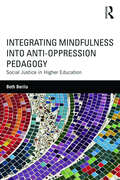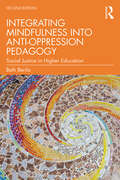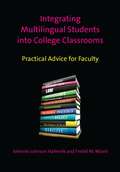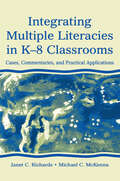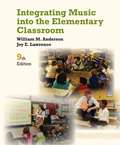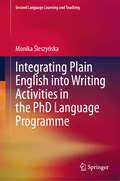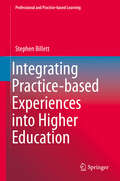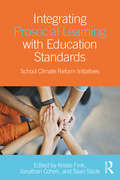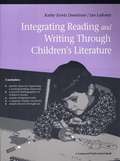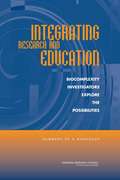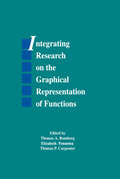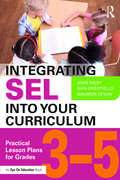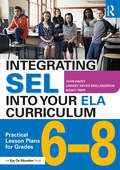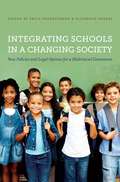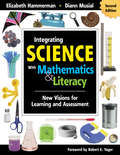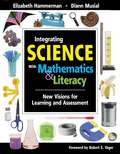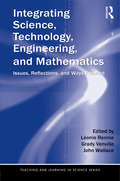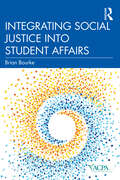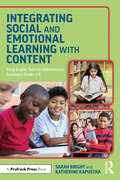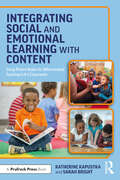- Table View
- List View
Integrating Mindfulness into Anti-Oppression Pedagogy: Social Justice in Higher Education
by Beth BerilaDrawing from mindfulness education and social justice teaching, this book explores an anti-oppressive pedagogy for university and college classrooms. Authentic classroom discussions about oppression and diversity can be difficult; a mindful approach allows students to explore their experiences with compassion and to engage in critical inquiry to confront their deeply held beliefs and value systems. This engaging book is full of practical tips for deepening learning, addressing challenging situations, and providing mindfulness practices in anti-oppression classrooms. Integrating Mindfulness into Anti-Oppression Pedagogy is for all higher education professionals interested in pedagogy that empowers and engages students in the complex unlearning of oppression.
Integrating Mindfulness into Anti-Oppression Pedagogy: Social Justice in Higher Education
by Beth BerilaDrawing from mindfulness education and social justice teaching, this book explores an effective Anti-Oppression pedagogy for university and college classrooms. Authentic classroom discussions about oppression and diversity can be difficult; a mindful approach allows students to explore their experiences with compassion and to engage in critical inquiry to confront their deeply held beliefs and value systems. This engaging book is full of practical tips for deepening learning, addressing challenging situations, and providing mindfulness practices in anti-oppression classrooms. In this fully revised edition, Dr. Berila positions discussion in the current context and expands exploration of power and implicit bias, transformative learning, and trauma. Integrating Mindfulness into Anti-Oppression Pedagogy is for all higher education professionals interested in and teaching Social Justice pedagogy that empowers and engages students in the complex unlearning of oppression.
Integrating Multilingual Students into College Classrooms
by Johnnie Johnson Hafernik Fredel M. WiantToday more and more ethnically, culturally, and linguistically diverse students enroll in our college and university courses. These diverse, multilingual students enrich our campuses and at the same time present challenges. Who are these students? What skills do these diverse students need to be successful in college? How can faculty help them succeed? For faculty in all disciplines seeking answers to these questions, this is an essential book. This text provides practical advice on how to assist these students with academic tasks and how to help them to succeed in the academy.
Integrating Multiple Literacies in K-8 Classrooms: Cases, Commentaries, and Practical Applications
by Janet C. Richards Michael C. McKennaThis text gives prospective and practicing teachers a comprehensive understanding of how to teach multiple literacies in elementary and middle school classrooms. All of the literacies--dance, music, visual arts, popular culture, media, and computer technologies--are integrated with reading and writing. Balanced treatment is given to theoretical perspectives and practical applications. The text features authentic cases written by preservice teachers, and commentaries on the cases from practitioners and university professors. The cases are designed to prepare future teachers for the PRAXIS teacher certifying exam and others offered in many states. Three theoretical chapters support the practical applications: *Chapter 1 addresses the benefits of writing and analyzing cases and the specific attributes of exemplary teaching cases, and offers guidelines for teachers to author their own case narratives and questions for analyzing and discussing case issues with peers. *Chapter 2 discusses the role of electronic symbol making and multiple sign systems in children's literacy and how children use symbols to receive and express meaning. *Chapter 3 offers a theoretical framework that helps define and enable teachers to use the new literacies of Internet technology, and provides a strong rationale for expanding traditional definitions of literacy. The practical applications chapters (chaps. 4-12) gradually lead readers toward a deeper understanding of how to conceptualize and structure more complex, integrated lessons. In each of these chapters: *An "Overview" provides up-to-date information about the particular form of literacy discussed in the chapter. *A helpful "What Do You Need to Know and How Do You Begin" section offers ideas and tasks for teachers who wish to nurture their artistic and technological aptitudes, expand their understanding of popular culture media, and increase their knowledge about integrating diverse communication forms into cohesive themed units or instruction. *Exemplary cases--the heart of these chapters--present preservice teachers' candid descriptions of their reflections, confusions, and concerns as they support K-8 students writing and writing development through multiple literacy approaches. *Case-specific questions encourage readers to take an active part in analyzing, documenting, and discussing the particular issues raised. *"Commentaries" by skilled practitioners and university professors provide sound teaching suggestions, scholarly perspectives, and sometimes contrasting solutions to the dilemmas described in the cases. *"Reflections and Explorations" activities help teachers become more actively involved in thinking and learning about multiple literacies. *"Practical Applications" questions engage teachers in considering their own teaching environments and goals as they integrate multiple literacy lessons into their curriculum. *"Suggested Readings" support teachers in constructing more in-depth knowledge about the chapter topics.
Integrating Music into the Elementary Classroom
by William M. Anderson Joy E. LawrenceThe market-leading text for the Elementary School Music Methods course, INTEGRATING MUSIC INTO THE ELEMENTARY CLASSROOM was the first to emphasize the theme of integrating music throughout the school day. Anderson and Lawrence show future educators how to make music an effective part of the entire elementary curriculum. The text introduces songs, instruments, sources of age-appropriate music, and methods of making music in a multicultural environment -- making it perfect for students with no prior knowledge of music fundamentals. With easy techniques for teaching young children how to sing, play instruments, move to music, create music, listen to music, and understand music, this text relates music to all subject areas. Notably, the authors provide sample lesson plans for kindergarten through sixth grade, along with more than 150 songs from different cultures and historical periods.
Integrating Plain English into Writing Activities in the PhD Language Programme (Second Language Learning and Teaching)
by Monika ŚleszyńskaThis book explores the intersection of writing theory, language simplification, and academic communication, with a specific focus on integrating plain English into doctoral education. Through five comprehensive chapters, the book discusses essential topics such as the principles of effective writing, the role of clarity and readability in academic texts, and the significance of plain English for enhancing scientific writing skills. Chapter 1 offers an overview of writing theory, emphasizing key concepts that impact the clarity and readability of written texts. Chapter 2 examines the importance of language simplification, particularly in scientific publishing, while Chapter 3 highlights writing challenges in target language classrooms, with a focus on writing development. In Chapter 4, the book provides the context for a groundbreaking empirical study, justifying the use of plain English in PhD language programmes. Chapter 5 presents detailed data analysis, key findings, and implications for future research, demonstrating how the teaching of plain English enhances doctoral students' writing skills, empowers them as publishable authors, and improves the overall quality of their scientific work. Given the limited research on this topic in Polish educational settings, this book is of interest to scholars and English language teachers in doctoral programmes.
Integrating Practice-based Experiences into Higher Education
by Stephen BillettThis book advances understandings about and practices for effectively integrating practice-based (e. g. workplace) experiences in higher education programs. This issue is becoming of increasing salient because higher education programs globally are increasingly focussing on preparing students for specific occupations. Such imperatives are reflected in the cooperative education movement in North America, the foundation degree programs of the United Kingdom, the work integrated learning approach within Australian higher education and initiatives in a range of other countries. There are clear and growing expectations that graduates from such should be able to move smoothly into being effective in their occupational practice. These expectations rise from the imperatives and interest of government, employers, community and students themselves. The book achieves a number of important goals. Firstly, it identifies and delineates the educational worth of students and engagement in practice-based experiences and their integration within their programs of study. Secondly, it advances conceptions of the integration of such experiences that is essential to inform how these programs might be enacted. Thirdly, drawing on the findings of two teaching fellowships, it proposed bases and propositions for how experiences in higher education programs might be organised and augmented to support effective learning. Fourthly pedagogic practices seen to be effective in maximising the learning from those practice experiences and integrating them within the curriculum are identified and discussed. Fifthly, a particular focus is given to students' personal epistemologies and how these might be developed and directed towards supporting effective learning within practice settings and the integration of that learning in their university programs.
Integrating Prosocial Learning with Education Standards: School Climate Reform Initiatives
by Jonathan Cohen Sean Slade Kristie FinkIntegrating Prosocial Learning with Education Standards demonstrates how to meet educational standards that privilege cognitive aspects of learning while also advancing prosocial or Whole Child efforts (e.g., social emotional learning, character education, and mental health promotion). The book utilizes a growing body of research to reveal effective ways to implement a curriculum that integrates social, emotional, ethical, and civic aspects of learning with required state standards, and a wide range of "real world" examples describe how any school, anywhere, can lay a foundation for all young people to succeed.
Integrating Pupils with Disabilities in Mainstream Schools: Making It Happen
by Helen KenwardFirst Published in 1998. Routledge is an imprint of Taylor & Francis, an informa company.
Integrating Racial Justice Into Your High-School Biology Classroom: Using Evolution to Understand Diversity
by David E. Fastovsky David UpeguiIn this guide, educators and authors David Upegui and David E. Fastovsky offer a pedagogical prescription for how you can integrate the study of racial justice with evolutionary biology in your existing high-school biology curriculum. Designed as a practical manual for teaching, the chapters focus on teaching concepts of equity through evolutionary biology modules, a cornerstone for building students’ scientific understanding of biotic diversity. The book provides pedagogical components alongside historical and scientific components, with contextual chapters that give teachers the background knowledge to understand the historical relationship between science and racism for topics such as natural selection, social justice, and American slavery and colonization. Ready-to-use lesson plans are situated in a historical and theoretical context of science as it relates to racial oppression, and demonstrate how rigorous science education can lead to your students’ liberation and personal empowerment despite the historically problematic history of some applications of science. These lesson plans and classroom exercises are presented in a way that introduces the timely extra dimension of anti-racism into the existing biology curricula without significantly increasing teaching loads. The contextual material provided allows the lessons to be implemented across a variety of classrooms regardless of initial familiarity with DEI. Ideal for secondary biology teachers and their students, particularly in grades 10-12, this book synthesizes timely ideas for high-school educators, harnessing the power of rigorous science to combat marginalization. Lessons and activities have been classroom-tested and are aligned with three different standards: Next Generation Science Standards (NGSS); College board (AP Biology); Vision and Change; and use the 5E format.
Integrating Racial Justice Into Your High-School Biology Classroom: Using Evolution to Understand Diversity
by David E. Fastovsky David UpeguiIn this guide, educators and authors David Upegui and David E. Fastovsky offer a pedagogical prescription for how you can integrate the study of racial justice with evolutionary biology in your existing high-school biology curriculum.Designed as a practical manual for teaching, the chapters focus on teaching concepts of equity through evolutionary biology modules, a cornerstone for building students’ scientific understanding of biotic diversity. The book provides pedagogical components alongside historical and scientific components, with contextual chapters that give teachers the background knowledge to understand the historical relationship between science and racism for topics such as natural selection, social justice, and American slavery and colonization. Ready-to-use lesson plans are situated in a historical and theoretical context of science as it relates to racial oppression, and demonstrate how rigorous science education can lead to your students’ liberation and personal empowerment despite the historically problematic history of some applications of science. These lesson plans and classroom exercises are presented in a way that introduces the timely extra dimension of anti-racism into the existing biology curricula without significantly increasing teaching loads. The contextual material provided allows the lessons to be implemented across a variety of classrooms regardless of initial familiarity with DEI.Ideal for secondary biology teachers and their students, particularly in grades 10-12, this book synthesizes timely ideas for high-school educators, harnessing the power of rigorous science to combat marginalization. Lessons and activities have been classroom-tested and are aligned with three different standards: Next Generation Science Standards (NGSS); College board (AP Biology); Vision and Change; and use the 5E format.
Integrating Reading and Writing Through Children's Literature
by Kathy Everts Danielson Jan LabontyLanguage arts teachers (and future teachers) will find strategies for presenting student-centered and integrated literacy classes.
Integrating Research And Education: Biocomplexity Investigators Explore The Possibilities
by Bridget K. B. AvilaThe workshop summary provides guidance for researchers applying to the National Science Foundation (NSF) for funding. New NSF guidelines require applications to address the "broader impact" of the proposed research. Presentations at the workshop provided ideas on how to do this by engaging in undergraduate education, K-12 education or public outreach via museums or journalists. The workshop summary discusses issues to consider in choosing an appropriate collaborator for the education or outreach component of the project and how to build in methods for assessing the success of the project. It also provides lists of resources helpful in writing education proposals and discusses the similarities between research in education and scientific research.
Integrating Research on the Graphical Representation of Functions (Studies in Mathematical Thinking and Learning Series)
by Thomas P. Carpenter Elizabeth Fennema Thomas A. RombergThis volume focuses on the important mathematical idea of functions that, with the technology of computers and calculators, can be dynamically represented in ways that have not been possible previously. The book's editors contend that as result of recent technological developments combined with the integrated knowledge available from research on teaching, instruction, students' thinking, and assessment, curriculum developers, researchers, and teacher educators are faced with an unprecedented opportunity for making dramatic changes. The book presents content considerations that occur when the mathematics of graphs and functions relate to curriculum. It also examines content in a carefully considered integration of research that conveys where the field stands and where it might go. Drawing heavily on their own work, the chapter authors reconceptualize research in their specific areas so that this knowledge is integrated with the others' strands. This model for synthesizing research can serve as a paradigm for how research in mathematics education can -- and probably should -- proceed.
Integrating SEL into Your Curriculum: Practical Lesson Plans for Grades 3–5
by John Dacey Gian Criscitiello Maureen DevlinIn this helpful new book, John Dacey, Gian Criscitiello, and Maureen Devlin show you how to seamlessly infuse social and emotional learning into your curriculum. With the growing emphasis on student assessment and learning outcomes, many teachers find they lack the time and the encouragement to begin implementing SEL techniques into their instruction. This book offers a solution in the form of practical lesson plans for grades 3–5 in ELA, math, social studies, and science—all of which can be implemented without tedious preparation and all of which are designed to boost creativity, cooperation, concentration, and critical thinking. Your students will learn how to… Evaluate the costs and benefits of their decision-making; Connect daily choices to an overarching sense of purpose; Judge independently and pursue self-awareness; Assess, harness, and transform emotions as a strategic resource; Gain energy from personal values and commitments; and Practice mindfulness and think positively. Each chapter contains a number of reproducible tools that can be photocopied from the book or downloaded as eResources from the book product page at www.routledge.com/9781138632066.
Integrating SEL into Your ELA Curriculum: Practical Lesson Plans for Grades 6-8
by John Dacey Lindsey Neves Baillargeron Nancy TrippIn this helpful book, you’ll learn how to seamlessly infuse social-emotional learning into your middle school English language arts curriculum. With the growing emphasis on student assessment and learning outcomes, many teachers find they lack the time and the encouragement to begin implementing SEL techniques into their instruction. This book offers a solution in the form of practical lesson plans—all of which can be implemented without tedious preparation and all of which are designed to boost self-awareness, self-management, social awareness, and other key SEL skills. Your students will discover how to… Practice mindfulness and think positively, Exert self-control and employ self-management skills, Become independent thinkers and make sound decisions, Be resilient and develop a growth mindset, Improve relationship skills and avoid bullying, Be authentic and develop leadership skills, And much more! Each activity is ELA-focused, so students will develop social-emotional learning while meeting key literacy objectives such as reading a nonfiction speech, looking closely at symbolism, analyzing Shakespearean sonnets, and more. The book also includes reproducible tools for classroom use. You can photocopy them or download them as eResources from www.routledge.com/9781138345263.
Integrating STEM in Higher Education: Addressing Global Issues
by Lindsey N. ConnerThis timely book addresses the increasing need for collaboration, innovation and solution-focussed skills by looking at examples of cutting-edge pedagogy that can inform future directions. Integrating STEM in Higher Education shows how applying digital innovations that can be generated through the implementation of deliberately designed STEM education can change the world for the better. References to over 45 higher education institutions from around the world are included, where integrated approaches are already occurring. A wide range of teaching strategies and assessment methods are discussed, promoting a transformative method in which students can generate new knowledge within coursework and simultaneously develop skills and attributes for their future careers, lives and the world’s needs. This book is essential reading for STEM educators, administrators and academic leaders, as well as learning designers in higher education.
Integrating Schools in a Changing Society
by Erica Frankenberg Elizabeth DebrayIn this comprehensive volume, a roster of leading scholars in educational policy and related fields offer eighteen essays seeking to illuminate new ways for American public education to counter persistent racial and socioeconomic inequality in our society. Contributors to Integrating Schools in a Changing Society draw on extensive research to reinforce the key benefits of racially integrated schools, examine remaining options to pursue multiracial integration, and discuss case examples that suggest how to build support for those efforts.
Integrating Science With Mathematics & Literacy: New Visions for Learning and Assessment
by Elizabeth Hammerman Dr Diann L. MusialFeatures tasks that model inquiry-based science and helps teachers evaluate learners' acquisition of complex thinking skills, aptitude for science, and ability to make real-world connections.
Integrating Science with Mathematics & Literacy: New Visions for Learning and Assessment
by Elizabeth Hammerman Diann MusialChallenge and expand students' abilities with multidimensional performance tasks!In this invaluable resource, science educators Elizabeth Hammerman and Diann Musial define a new vision for integrating science, mathematics, and language arts with instruction and assessment and encourage teachers to develop reliable processes for assessing both their teaching practice and student learning.This revised edition offers more than 20 performance assessments that promote student engagement. Each clearly articulated task correlates with current research and focuses on learning indicators linked to state and national standards. The assessments also model inquiry-based science in ways proven to increase student achievement, allowing learners to demonstrate their understanding of embedded concepts through exploration, inquiry, and application.Teachers can follow detailed guidelines to develop customized assessments or use the assessments already included to evaluate learners': Understanding of content and processes Development of complex thinking skills Aptitude for science Ability to make real-world connectionsFeaturing learning logs, portfolios, peer interview strategies, and sample teacher-student interviews, Integrating Science With Mathematics and Literacy, Second Edition, helps educators obtain accurate performance data while giving students opportunities to examine the world in exciting ways.
Integrating Science, Technology, Engineering, and Mathematics: Issues, Reflections, and Ways Forward (Teaching and Learning in Science Series)
by Léonie Rennie, Grady Venville, and John WallaceHow can curriculum integration of school science with the related disciplines of technology, engineering and mathematics (STEM) enhance students’ skills and their ability to link what they learn in school with the world outside the classroom? Featuring actual case studies of teachers’ attempts to integrate their curriculum, their reasons for doing so, how they did it, and their reflections on the outcomes, this book encourages science educators to consider the purposes and potential outcomes of this approach and raises important questions about the place of science in the school curriculum. It takes an honest approach to real issues that arise in curriculum integration in a range of education contexts at the elementary and middle school levels. The clear documentation and critical analysis of the contribution of science in curriculum integration—its implementation and its strengths and weaknesses—will assist teachers, science educators, and researchers to understand how this approach can work to engage students and improve their learning, as well as how it does not happen easily, and how various factors can facilitate or hinder successful integration.
Integrating Service Learning and Multicultural Education in Colleges and Universities
by Carolyn R. O’GradyThe focus of this book is on the ways in which service learning and multicultural education can and should be integrated so that each may be strengthened and consequently have greater effect on educational and social conditions. It offers a significant attempt to forge a dialogue among practitioners of service learning and multicultural education. The overriding theme is that service learning without a focused attention to the complexity of racial and cultural differences can reinforce the dominant cultural ideology, but academic work that seeks to deconstruct these norms without providing a community-based touchstone isolates students and schools from the realities of the larger communities of which they are part. Although the chapter authors provide varied perspectives on the benefits and challenges of integrating multicultural education and service learning, they all are committed to a vision of education that synthesizes both action and reflection. None of the authors pretend to have all the answers to what this integration should look like, nor do they believe that today's social problems are easily ameliorated through education. Rather, they share theories, practices, failures, and triumphs in order to further the conversation about the importance of aligning what educators say about the world and how they act in and on it. These authors share the view that multicultural education is truly transformative for students only when it includes a community action component, and likewise, service learning is truly a catalyst for change only when it is done from a multicultural and socially just perspective. It is their hope that the ideas explored in this book will further the work of those who share a commitment to the integration of action and reflection.
Integrating Social Justice into Student Affairs
by Brian BourkePushing back on the critique that social justice is often just a buzzword in student affairs, this book provides guidance on how to truly make social justice a fundamental part of student affairs.Shaped by voices of student affairs educators and up-to-date literature, Bourke offers guidance on how to approach social justice effectively and confidently as a student affairs educator. This book provides discussion of the core concepts connected to social justice, strategies for making social justice part of one's practice, and guidance on how to infuse social justice into practice throughout the field. Each chapter features reflection and discussion questions, as well as suggestions for further reading aiming to provide readers with fresh perspectives on how to center social justice in student affairs.Filled with extensive research, practical measures, and engaging prompts, this book serves as a launchpad for student affairs educators to be intentional with their practice and put words into action.
Integrating Social and Emotional Learning with Content: Using Graphic Texts for Differentiated Teaching in Grade 3-5 Classrooms
by Katherine Kapustka Sarah BrightThis book provides a framework for creatively and effectively teaching social and emotional learning across content areas in grades 3–5 using illustrated texts such as graphic novels, manga, and picture books.Thoughtful book choices that reflect the range of diversities found in classrooms and communities help support students as they develop their academic skills, and provide opportunities to address their unique socio-emotional needs. Covering theoretical context, the benefits of using graphic texts to activate important cognitive structures, as well as specific techniques and advice for implementation, this book makes pairing effective, diverse books with thoughtfully designed, standards-aligned lessons encouragingly simple.Packed with adaptable lesson plans, book lists, differentiated activities and more, this book is a must read for educators seeking truly integrated learning experiences that meet all learners’ academic and social and emotional learning (SEL) needs.
Integrating Social and Emotional Learning with Content: Using Picture Books for Differentiated Teaching in K-3 Classrooms
by Katherine Kapustka Sarah BrightIntegrating Social and Emotional Learning with Content builds a framework for creatively and effectively using picture books to integrate social and emotional learning (SEL) with teaching across content areas. Thoughtful book choices in mixed-ability early elementary classrooms have the power to not only support gifted students as they develop academically, but also to provide an opportunity to address their unique social and emotional needs, such as asynchronous development and an early awareness of complex and challenging issues in their lives and the world at large. Picture books are an invaluable tool for this work because the characters, topics, and settings increasingly represent and celebrate the lived experiences of diverse student populations, supporting culturally responsive teaching. Packed with lesson plans, book lists, and more, this book is perfect for teachers in gifted and mixed-ability classrooms as well as homeschooling parents looking to help their children make meaningful connections between their culture, languages, and lived experiences and the academic content and SEL skills they are being taught in the classroom.
